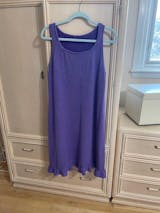Mastering the perfect non-roll waistband
Contoured, yoga, wide... In activewear and loungewear, you will see many types of waistbands. Wide waistbands are very comfortable and stay put, but as you may have experienced in the past in ready to wear (or other pattern brands), some waistbands tend to roll down or won't stay in place.

That happens when the waistband is too big at the top (is not snug enough against the body), but a hidden elastic can be the secret for a perfect waistband that won't budge. That is what we use in many of our patterns and we will explain to you in this post how to sew it, as the technique may differ from other elastic applications you have see in the past.
Assemble the waistband
Follow the pattern instructions to get your waistband and it's facing (usually the same pieces as the outer layer of the waistband) ready.
For the Sylvie pants, you need to pin at side seams:

Then, insert the facing into the outer layer of the waistband, right sides together and matching seams and notches:

Stitch along the top edge:

Mark center front, center back, and quarters (you will find them by bringing centers together).
Did you know that instructions for all patterns are available for download before purchase? At any time, you can click "View Instructions" under the "Details, Sizing and Instructions" section of any pattern page.
Prepare the elastic
Cut the elastic to the length indicated on the pattern. The width of the elastic may vary based on the pattern or size you are making.
Overlap elastic ends and stitch to form a loop:

Mark half and then quarters with pins (bring half marks together to find the quarter)
Apply the elastic
With the waistband wrong side out, pin the elastic to the top seam allowance, along the seam, matching the quarter pins.

The seam allowance is narrower than your elastic. It feels/look odd, but trust us on this one :)

Stitch on the elastic using a zigzag stitch (medium-wide, fairly long), stretching the elastic between the pins. Make sure the elastic remains above the seam as you sew.

Understitch
Bring the elastic towards the inner layer of your waistband and stitch, using a zigzag, going through all layers and stretching the elastic flat as you sew:

Bring wrong sides of waistband together and baste raw edges with a zigzag, matching notches and side seams:

The understitching is only visible on the inside of your waistband. Pin the outer side of the waistband to the right side of the waist opening, notches and seams together, and stitch:

You are ready to continue with assembly. For this tiny kids pair of Sylvie lounge pants, we used a blind hem foot attachment on our serger to finish the hem:

More about it on the Janome life blog.
Try the technique on your favorite bottoms pattern
The waistband of each of the following sewing patterns has a concealed elastic that is sewn using the technique described in this blog post:
← Turn the Claudia bikini into an unlined bralette Jalie sewing techniques - How to assemble PDF patterns →









